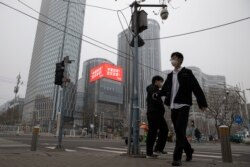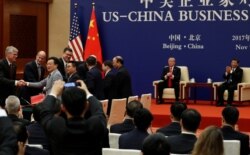American businesses operating in China have turned bearish about the Chinese economy after more companies reported drops in revenues and market demand as a result of the global coronavirus pandemic, a U.S. business lobby’s survey showed on Wednesday.
Some 76% of 119 company executives expressed a pessimistic outlook towards China’s future economic growth, according to an American Chamber of Commerce in China (AmCham China) survey.
The survey showed that the consumer, resource and industrial sectors are most pessimistic about the disease’s impact, with 38% of them expecting a decrease of 50% or more in future growth.
That sentiment was in line with recent economic forecasts.
GDP cuts
On Monday, a prominent investment bank in China — China International Capital Corp — cut its 2020 GDP forecast for China to 2.6%, sharply down from 6.1% in January, according to the South Morning China Post.
That compared with Nomura Bank, which has slashed its 2020 growth forecasts for China to 1.3% from the previous 4.8%, while Bank of America Merrill Lynch has also cut its China forecast for this year to 1.5%.
The AmCham survey, conducted before March 18, also showed that 50% of respondent companies were experiencing significant revenue declines and 39% said demand for their products was down — respectively up from 28% and 22% in last month’s survey.
Already, 14% of respondents were seeing a daily loss of $70,705 (500,000 yuan), up from 10% in Feb.
Drops in revenue and demand
If businesses fail to return to normal by the end of April, 57% of respondents, up from 48% in February, expect this year’s revenues in China to decrease.
Should businesses only return to normal after September, half of respondents expected a revenue drop of under 50% while another 13% expected a drop greater than 50%, according to the survey.
As the virus continues to devastate Western countries, U.S. companies are now worried about its global impact, said the chamber’s chairman Greg Gilligan.
The chamber called on both the Chinese and parent U.S. governments to offer relief measures including tax cuts and financing.
Relief measures needed
Gilligan said hundreds of the chamber’s members had already engaged, in an earlier online discussion, with Chinese officials, led by Vice Minister of Commerce Wang Shouwen, to explore potential solutions.
“In the tax side, we highlighted that we needed frankly national treatment such that any relief measures will be available to all businesses not just businesses depending on their countries of origin etc… And so, we were given assurance around those things,” Gilligan told an online media briefing on Monday.
He said medium-sized enterprises (SMEs), which are vulnerable to cash crunch, are in desperate need of such relief measures.
But the chamber hopes that the measures can also be extended to large companies.
“Large corporates are actually linchpins for SMEs because SMEs are often in the up or down steams of their ecosystem. So, support for large corporates is in fact support for SMEs as well,” Gilligan added.
When it comes to investment, 40% of respondents said they would maintain previously planned investment levels while 10% planned to decrease investment, the survey showed.
Emerging new opportunities
On the bright side, however, around 40% of U.S. business respondents are optimistic about prospects for China’s further reforms and market opening, although 44% of them are pessimistic about upcoming negotiations of the U.S.-China phase-two trade deal.
The chamber, moreover, hopes to help member companies — especially those in the technology and healthcare sectors — to identify new business opportunities amid the health crisis.
“The 40% [of the technology & other R&D-intensive sectors] are actually projecting an increase in market growth… That, of course, is because the use of technology by business and society at large has experienced an uptick as a result of the epidemic,” the chamber’s president, Alan Beebe, told the same online media briefing.
The chamber said that the world can look to China’s experience as it has been a global leader in the adoption of e-commerce.
The chamber, which has long advocated more private-sector participation in China’s healthcare system, will look to promote public-private partnership, hoping that the crisis will serve as a catalyst for China to upgrade its healthcare system, Beebe said.
Joerg Wuttke, president of the European Chamber, also urged China to advance its reform agenda after the chamber’s online meeting with Chinese officials last week.
“We must do more than merely troubleshoot the issues… but also advance a proactive effort to help shape the form that a new round of economic liberalization may take,” he said in a press statement released on Monday.
Disrupted supply of raw materials
Following the relaxation of lockdown policies in major Chinese cities, the supply of workforce is no longer a headache for most China-based Taiwanese electronic makers, according to Yen Shu-chiu, deputy secretary-general of the Taiwan Electrical and Electronic Manufacturers Association in Taipei.
However, manufacturers remain haunted by the disrupted supply of raw materials, which has kept their overall output level at under 50%, she said.
Another hurdle comes from transportation disruption as manufacturers there are having a hard time arranging transportation for delivery to their clients in the U.S or European countries, she added.
“The outbreak in China has slightly eased, but the condition in European countries and the U.S. is worsening. There remain lots of restrictions on logistics and transportation, which poses difficulty for Taiwanese businesses there,’ Yen said.














